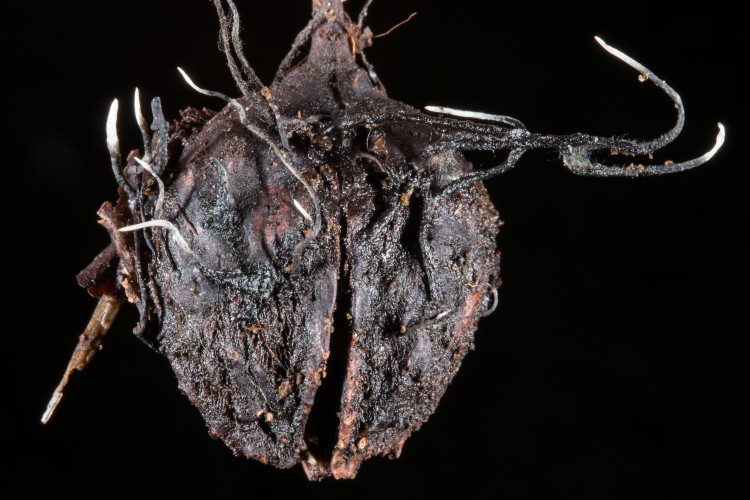We all know that fungi are not plants, but the Botanical Society of Scotland promotes the study of cryptogams and so fungi (as honorary plants) are very much within our remit.
Candlesnuff. Stag’s horn fungus. Carbon antlers. These are all names for a small, commonly encountered fungus that is found throughout the UK and Ireland, as well as in Europe and North America. There are records from South America, Australia, Africa and Asia too, if indeed these are all the same species. This fungus can be found at all times of the year and is very common, so will be known to many people. It is a good beginner fungus because it is quite recognisable and frequently found, and can be be particularly obvious in winter when there is less plant growth to hide it. It is not edible.
Candlesnuff feeds and grows on dead wood and is most usually found on the stumps, fallen logs and branches of deciduous trees. It tends to grow in groups. The fruiting bodies are variable in shape, from simple and cylindrical with narrow tips, to branched forms resembling tiny deer antlers or moose antlers. They can grow up to around 8cm, but are often shorter. Older specimens are entirely black, but younger ones are bicolored, with the top half a bright white. This white shade is caused by a powdery coating of asexual spores, called conidia, that gradually disperse over time. When this happens, the white fades to grey, then away. The sexual spores develop in flask-like structures, called perithecia, inside the main fruiting body. These perithecia are visible as tiny bumps on the surface of the fungus. The base of the fruiting bodies is hairy.

The presence of perithecia shows that this fungus belongs in the Ascomycota, one of the main divisions of the fungal kingdom (Basidiomycota is the division that all the gilled mushrooms 🍄 are found in). It is in the family Xylariaceae.
The reason for the name Stag’s horn fungus is clear: the fungus’s branched shape. The black, charcoal-like fruiting bodies take the name carbon antlers well. My preferred name is candlesnuff, though: with their powdery coating looking like ash on a burnt wick, it suits well enough, but even better is what happens if you give one of these a gentle flick. Do this and a puff of pale spores emerges and floats away like smoke when you blow out a candle.
An interesting quality of this fungus is that it possesses bioluminescence: the ability to emit light. You may have seen images of some mushrooms that glow with a bright green light, such as the Australian Omphalotus nidiformis; the honey fungi Armillaria do not have glowing mushrooms but emit light from their mycelium. In general, bioluminescent fungi glow due to the interaction between chemicals named luciferins and enzymes named luciferase in their tissues. It is thought that Xylaria hypoxylon, however, can emit light due to chemical reactions of phosphorus in its cells. Alas, this light is so weak that it is next to invisible.

A similar-looking, but much smaller, related species is the Beechmast Candlesnuff fungus, which (as its name implies) grows on the decaying fruit cases of beech trees, Fagus sylvatica, known as beech masts. This has thin, spindly fruiting bodies that also possess white tips. Since this is a small fungus and is often hidden under leaf litter, finding it generally requires a bit of digging about under beech trees, but it’s worth it when you find some.
Image by Chris Jeffree

Keep an eye out also for Dead Man’s Fingers, Xylaria polymorpha, and the more slender Dead Moll’s Fingers, Xylaria longipes. These are both black or brownish, found in clusters and protrude upwards from their woody substrate, with some imagination like blackened fingers reaching up.
Image by Salicyna, CC BY-SA 4.0 via Wikimedia Commons
References
Xylaria hypoxylon on GBIF
Xylaria hypoxylon at First Nature
Candlesnuff fungus at Inner Forth Landscape
Jordan, Michael. The Encyclopedia of Fungi of Britain and Europe. David and Charles; 1995
Xylaria hypoxylon at mushroomexpert.com
Xylaria hypoxylon at Mykoweb.com
Phillips, Roger. Mushrooms; Macmillan; 2006
Waldenmaier, Hans E. et al. CIRCADIAN RHYTHM IN FUNGAL BIOLUMINESCENCE: NATURE’S BRIGHT IDEA. Microbiology Today, Issue: Light; 2015
The Monthly Mushroom at woodlands.co.uk
Xylaria: What, where, how? at xylaria.net
– Heather Forbes



